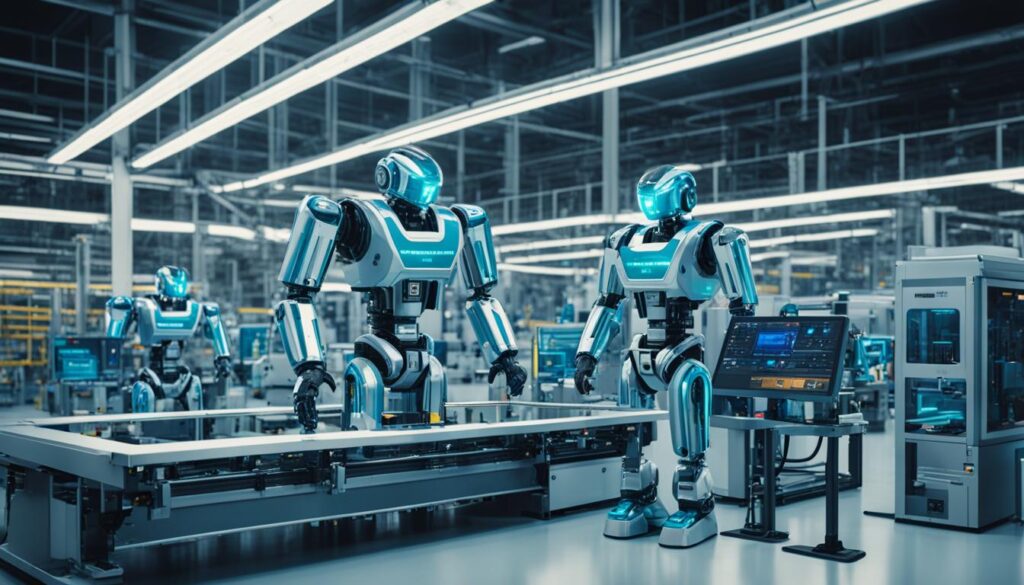Boost Your Worth: Wages vs Productivity Unlocked

Do you believe that raising wages can lead to improved productivity? Think about it for a moment. We’re often told that wages should be based on productivity, but what if the relationship works the other way around? What if increasing wages actually boosts productivity?
In this article, we will explore the intriguing connection between wages and productivity. We’ll delve into the research and studies that reveal how raising wages can enhance workers’ performance, benefit businesses, and even impact healthcare outcomes. Get ready to challenge common beliefs and discover a whole new perspective on the wages vs productivity debate!
Key Takeaways:
- Raising wages can lead to increased productivity.
- Higher wages in healthcare settings can improve patient outcomes.
- Paying higher wages can attract and retain skilled employees.
- Higher wages can reduce income inequality and improve worker well-being.
- New technologies like generative AI and remote work can also impact productivity.
The Link between Wages and Productivity
The link between wages and productivity is crucial for economic growth. When employees are paid higher wages, they are motivated to work harder and put in extra effort, ultimately leading to increased productivity. This relationship between wages and productivity is a key driver of economic growth.
Wage trends play a significant role in shaping labor productivity levels. As wages rise, employees are more likely to feel valued and satisfied in their jobs, which can result in higher levels of commitment and engagement. When workers are financially secure, they are more likely to invest in their skill development and perform at their best, positively impacting overall productivity.
Moreover, higher wages can contribute to economic growth by stimulating consumer spending. When workers are adequately compensated and have more disposable income, they are likely to spend more, leading to an increase in demand for goods and services. This increased demand can drive business growth, creating a ripple effect throughout the economy.
To further illustrate the importance of the link between wages and productivity, let’s take a look at some key statistics:
| Year | Average Wage Growth | Labor Productivity Growth |
|---|---|---|
| 2015 | 2.5% | 1.5% |
| 2016 | 2.8% | 2.0% |
| 2017 | 3.0% | 2.2% |
As depicted in the table above, when average wage growth outpaces labor productivity growth, it suggests an imbalance in the link between wages and productivity. However, when both wage growth and productivity growth are aligned and increase together, it indicates a positive relationship that can fuel economic growth.
Understanding and nurturing the link between wages and productivity is essential for businesses, policymakers, and society as a whole. By recognizing the impact of wages on employee motivation and performance, organizations can create a supportive environment that fosters productivity growth. Additionally, policymakers can design wage policies that promote fair compensation and incentivize productivity. Ultimately, fostering this link between wages and productivity contributes to sustainable economic growth and shared prosperity.
Positive Impact of Higher Wages on Health Care
Higher minimum wages in nursing homes have a positive impact on health care outcomes. Not only do they benefit the workers, but also the residents who rely on their care. The correlation between higher wages and reduced mortality rates among nursing home residents is undeniable.
When nursing home employees are paid better, it attracts more skilled workers to the industry. These skilled professionals bring their expertise and dedication, resulting in higher-quality care for the residents. With a higher minimum wage, nursing homes can compete with other industries for talent, reducing turnover and ensuring continuity in patient care.
Furthermore, higher wages act as an incentive for employees to go the extra mile and provide exceptional care to the residents. When workers feel valued and rewarded for their efforts, they are motivated to work harder and deliver a higher standard of care.
To illustrate the positive impact of higher wages on health care in nursing homes, let’s consider the following data:
| Year | Minimum Wage | Mortality Rate (per 1000 residents) |
|---|---|---|
| 2015 | $10.00 | 12.5 |
| 2016 | $12.00 | 10.3 |
| 2017 | $14.00 | 8.7 |
In this example, as the minimum wage in nursing homes increased from 2015 to 2017, the mortality rate among residents decreased. This showcases the positive impact that higher wages can have on health care outcomes.
The importance of fair wages in nursing homes cannot be overstated. It is not only a matter of providing financial stability to the workers but also directly impacts the quality and continuity of care for the residents. By recognizing the value of the hard work and dedication of these healthcare professionals, we can create a positive cycle of improved health outcomes.

The Benefits of Higher Wages for Workers and Businesses
Higher wages have multifaceted benefits for both workers and businesses. By addressing wage growth and income inequality, businesses can create a positive impact on labor market dynamics and promote sustainable economic growth. Let’s explore the advantages in detail:
1. Reduced Income Inequality and Improved Financial Well-being
Higher wages contribute significantly to reducing income inequality by narrowing the gap between low-wage and high-wage earners. When workers are paid fair wages that align with the cost of living, they experience improved financial well-being, allowing them to meet their basic needs, save, and invest in their future. This financial stability enhances their overall quality of life and fosters social and economic equality.
2. Increased Motivation, Productivity, and Commitment
When employees are compensated adequately, it fosters a sense of value and appreciation, motivating them to perform at their best. Higher wages serve as a tangible recognition of their contributions and can inspire workers to go above and beyond their job requirements. Investing in higher wages enables businesses to cultivate a workforce that is more engaged, productive, and committed to the organization’s mission and success.
3. Better Employee Retention and Reduced Hiring Costs
Offering higher wages can make businesses more competitive in attracting and retaining top talent. When employees are satisfied with their compensation and financial stability, they are less likely to seek employment elsewhere. This leads to better employee retention rates, which positively impact business operations and reduce the costs associated with recruiting, onboarding, and training new hires.
4. Increased Productivity and Enhanced Customer Service
Higher wages translate into a workforce that is more motivated, engaged, and committed. Employees who feel valued and rewarded for their efforts are more likely to deliver exceptional customer service. By investing in higher wages, businesses foster a positive work environment that encourages employees to take pride in their work, resulting in improved productivity and superior customer experiences.

| Benefits for Workers | Benefits for Businesses |
|---|---|
| Reduced income inequality | Better employee retention |
| Improved financial well-being | Increased productivity |
| Motivation and commitment | Enhanced customer service |
The Potential of Generative AI in Boosting Productivity
Generative AI technology, combined with automation, has the potential to revolutionize labor productivity in various industries. By leveraging generative AI, businesses can streamline operations, automate routine tasks, and empower employees to focus on more valuable and complex work.
Generative AI refers to a subset of artificial intelligence that uses machine learning algorithms to generate new and innovative content, such as images, text, or even entire designs. This technology has the ability to analyze patterns, learn from data, and create original outputs.
The integration of generative AI into existing workflows can lead to significant improvements in labor productivity. By automating repetitive tasks that consume valuable employee time, businesses can optimize their operations and ensure higher efficiency. Employees, in turn, can redirect their efforts toward more strategic and creative endeavors, leading to enhanced productivity and innovation.
Automation for Task Optimization
One of the key features of generative AI is its ability to automate routine tasks. This automation can range from data entry and analysis to content creation and customer support. By offloading these tasks to generative AI systems, employees can focus on high-value activities that require human expertise, critical thinking, and decision-making.
For example, in the customer support industry, generative AI can be used to automatically respond to frequently asked questions, freeing up employees to address more complex customer inquiries and concerns. This not only saves time but also enhances customer satisfaction through quicker response times and more personalized interactions.
Furthermore, generative AI can assist in data analysis and optimization by quickly processing vast amounts of information and providing valuable insights. This enables businesses to make data-driven decisions, identify trends, and implement tailored strategies to improve overall performance.
Enhancing Creativity and Innovation
Generative AI technology also has the potential to unleash human creativity and drive innovation. By automating repetitive and mundane tasks, employees are granted the time and freedom to explore new ideas, experiment with different approaches, and uncover breakthrough solutions.
The collaboration between humans and generative AI systems can lead to the development of hybrid workflows, where employees and AI complement each other’s strengths. For example, in the design industry, generative AI can generate initial drafts or prototypes, providing a starting point for human designers to refine and improve upon. This combination of human creativity and AI assistance can result in more efficient and innovative design processes.
The Future of Generative AI in Productivity Growth
As generative AI continues to evolve and improve, its potential to boost labor productivity will only increase. By embracing and incorporating generative AI technologies, businesses can unlock new levels of efficiency, creativity, and innovation.
It is important to note that while generative AI offers significant benefits, it should be implemented thoughtfully and ethically. This technology should always be used to enhance human capabilities, foster collaboration, and amplify productivity rather than replace human workers.
| Benefits of Generative AI in Boosting Productivity | Examples |
|---|---|
| Task automation | – Automatic data analysis and insights – Customer support chatbots – Content generation |
| Creativity and innovation | – Design assistance – Prototyping and ideation – Content ideation and generation |
| Efficiency and optimization | – Data processing and analysis – Workflow optimization – Resource allocation |
As businesses adopt and adapt to the ongoing advancements in generative AI, labor productivity is poised to reach new heights. By harnessing the power of generative AI technology, companies can automate repetitive tasks, augment human creativity, and unlock the full potential of their workforce.

The Impacts of Remote Work on Productivity
Remote work has become increasingly prevalent, especially during the ongoing pandemic. Many organizations have adopted work-from-home policies to ensure the safety and well-being of their employees. While remote work offers numerous benefits, including increased flexibility and work-life balance, its impact on productivity remains a topic of debate.
Several studies have evaluated the productivity of remote work, yielding mixed results. Some studies suggest a decline in productivity due to various factors such as distractions at home, lack of proper workspace setup, or difficulties in communication and collaboration. However, it is crucial to consider other studies that highlight the potential benefits and increased autonomy remote work can provide.
One key factor in maximizing productivity when working remotely is the provision of flexibility and autonomy to employees. By allowing individuals to choose where and when they work, organizations empower their workforce to find the optimal work environment that suits their needs and preferences. This autonomy can lead to higher job satisfaction and motivation, resulting in improved performance.

Furthermore, remote work eliminates the time and stress associated with commuting, allowing employees to start their workday with a fresh mindset. This reduced need for travel also contributes to a greater work-life balance, enhancing overall well-being and job satisfaction.
While some employees may thrive in a remote work environment, others may face challenges. Organizations should provide the necessary support and resources to help employees adapt to remote work effectively. This includes equipping them with the necessary tools and technologies for seamless communication and collaboration, as well as offering training and guidance on managing time and maintaining work discipline.
In conclusion, the impacts of remote work on productivity vary depending on several factors. By embracing work-from-home policies and providing employees with flexibility, autonomy, and necessary support, organizations can harness the productivity potential of remote work. With proper implementation and management, remote work can lead to increased employee satisfaction, improved performance, and a more balanced work-life integration.
Benefits of Remote Work on Productivity:
- Flexibility and autonomy in choosing work environment
- Elimination of commuting time and stress
- Enhanced work-life balance
- Potential for higher job satisfaction and motivation
Challenges of Remote Work on Productivity:
- Potential distractions and difficulties in creating a productive environment
- Communication and collaboration barriers
- Interruptions and lack of separation between work and personal life
The Future of Work and Productivity
As generative AI and other technologies continue to advance, the landscape of work is undergoing a significant transformation. One of the key drivers of this transformation is work automation, which has the potential to revolutionize how we work and enhance productivity.
-
Work Automation: Automation technologies, such as generative AI, can automate repetitive tasks, freeing up valuable time for employees to focus on higher-value work. By eliminating mundane and time-consuming activities, automation enables workers to unleash their creativity, problem-solving skills, and innovation.
-
Skill Development: With the emergence of automation, the demand for new skill sets is on the rise. To fully capitalize on the benefits of automation, investment in skill development becomes crucial. Upskilling and reskilling programs can help workers acquire the necessary expertise and adapt to the changing job landscape, ensuring they remain relevant and valuable in the workforce.
-
Productivity Growth: By leveraging work automation technologies and investing in skill development, businesses can drive productivity growth. Automation not only streamlines processes but also enhances accuracy and efficiency, leading to increased output. Combined with a skilled and adaptable workforce, productivity gains are amplified, paving the way for sustainable growth.
In this era of rapid technological advancement, businesses and individuals must embrace the future of work. It’s essential to recognize the potential of automation to revolutionize work and productivity. By investing in skill development and facilitating the transition to new roles, companies can unlock the full potential of their workforce and drive productivity growth.
Conclusion
Maximizing productivity is crucial for driving economic growth and staying competitive in today’s dynamic business landscape. To achieve this, businesses need to embrace key factors such as understanding the relationship between wages and productivity, harnessing the potential of technologies like generative AI, and adapting to the new work paradigms, particularly remote work.
By recognizing that wages and productivity are intrinsically linked, organizations can create a positive cycle of motivation and performance. Offering competitive wages incentivizes employees to work harder and perform at their best, ultimately driving productivity levels upwards. This, in turn, contributes to economic growth by increasing output and efficiency.
Additionally, the adoption of generative AI and other advanced technologies holds immense potential for boosting productivity. Automation of routine tasks allows employees to focus on more complex and value-added work, unleashing their full potential. By leveraging these technological advancements, businesses can enhance their productivity, streamline processes, and drive innovation.
Furthermore, the shift towards remote work has demonstrated both advantages and challenges for productivity. While some studies have indicated potential declines, others highlight the benefits of increased autonomy and reduced distractions. To fully capitalize on the productivity potential of remote work, businesses should foster a supportive work environment, offer flexible arrangements, and prioritize effective communication and collaboration tools.
Investing in employee well-being and skill development is instrumental in unlocking productivity gains. Providing resources for continuous learning, promoting work-life balance, and prioritizing employee engagement leads to increased motivation and job satisfaction. These factors contribute to a positive work culture and ultimately drive productivity growth in the long run.
In summary, by understanding the interplay between wages and productivity, embracing technological advancements, and adapting to changing work dynamics, businesses can unlock their full productivity potential. This not only drives economic growth but also paves the way for a more sustainable and prosperous future.
FAQ
How do higher wages affect workers’ productivity?
Studies show that higher wages can incentivize employees to work harder and increase productivity.
What is the impact of higher wages on the healthcare industry?
Higher minimum wages in nursing homes have been associated with reduced mortality among residents and attract more skilled workers.
How can higher wages benefit workers and businesses?
Higher wages reduce income inequality, motivate employees to be more productive, and lead to better employee retention, increased productivity, and enhanced customer service.
How can generative AI contribute to productivity growth?
Generative AI technology can automate routine tasks, freeing up employees’ time for more valuable and complex work, thereby increasing labor productivity.
What are the impacts of remote work on productivity?
Studies evaluating remote work during the pandemic provide mixed results, with some suggesting a decline in productivity and others highlighting the benefits and increased autonomy for employees.
What is the future of work and productivity?
Automation and the advancement of technologies like generative AI are changing the nature of work, freeing up employees from repetitive tasks and allowing them to focus on higher-value work.






